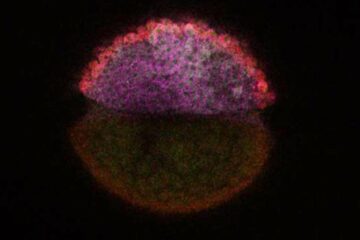Purple Light Means Go, Ultraviolet Light Means Stop

A new membrane developed at the University of Rochester's Laboratory for Laser Energetics blocks gas from flowing through it when one color of light is shined on its surface, and permits gas to flow through when another color of light is used. It is the first time that scientists have developed a membrane that can be controlled in this way by light.
Eric Glowacki, a graduate student at the University's Laboratory for Laser Energetics, and Kenneth Marshall, his advisor, invented the membrane. Marshall will present their findings at the annual conference of the International Society for Optics and Photonics (SPIE) in San Diego on Aug. 1.
The membrane is a piece of hard plastic riddled with tiny holes that are filled with liquid crystals and a dye. When purple light illuminates the surface of the membrane, the dye molecules straighten out and the liquid crystals fall into line, which allows gas to easily flow through the holes. But when ultraviolet light illuminates the surface, the dye molecules bend into a banana shape and the liquid crystals scatter into random orientations, clogging the tunnel and blocking gas from penetrating.
Controlling a membrane's permeability with light is preferable to controlling it with heat or electricity – two readily used alternative methods – for several reasons, Glowacki said. For starters, light can operate remotely. Instead of attaching electrical lines to the membrane, a lamp or a laser can be directed at the membrane from a distance. This could allow engineers to make much smaller, simpler setups.
Another advantage is that the color of the light illuminating the membrane can be changed precisely and almost instantaneously. Other methods, like heating and cooling, take a relatively long time and repeated heating and cooling can damage the membrane.
Also, light does not have the potential to ignite a gas, which could be a crucial benefit when working with hydrocarbons or other flammable gases. Lastly, the amount of light energy needed to switch the membrane on and off is miniscule.
Creating the membrane is a multi-step process. First, a circular hard plastic chip is bombarded with a beam of neutrons to make the tiny, evenly spaced holes that are about one-hundredth of a millimeter in diameter. The chip is then dipped in a solution of liquid crystals and dye, and the mixture fills the holes through capillary action. The final product is spun in a centrifuge to remove the excess liquid crystals from the surface.
The membrane could be useful in controlled drug delivery and industrial processing tasks that require the ability to turn the flow of gas on and off as well as in research applications.
Contact: Alan Blank
alan.blank@rochester.edu
585-275-2671
About the University of Rochester
The University of Rochester is one of the nation’s leading private universities. Located in Rochester, N.Y., the University gives students exceptional opportunities for interdisciplinary study and close collaboration with faculty through its unique cluster-based curriculum. Its College, School of Arts and Sciences, and Hajim School of Engineering and Applied Sciences are complemented by its Eastman School of Music, Simon School of Business, Warner School of Education, Laboratory for Laser Energetics, Schools of Medicine and Dentistry and Nursing, and the Memorial Art Gallery.
Media Contact
More Information:
http://www.rochester.eduAll latest news from the category: Power and Electrical Engineering
This topic covers issues related to energy generation, conversion, transportation and consumption and how the industry is addressing the challenge of energy efficiency in general.
innovations-report provides in-depth and informative reports and articles on subjects ranging from wind energy, fuel cell technology, solar energy, geothermal energy, petroleum, gas, nuclear engineering, alternative energy and energy efficiency to fusion, hydrogen and superconductor technologies.
Newest articles

Attosecond core-level spectroscopy reveals real-time molecular dynamics
Chemical reactions are complex mechanisms. Many different dynamical processes are involved, affecting both the electrons and the nucleus of the present atoms. Very often the strongly coupled electron and nuclear…

Columbia researchers “unzip” 2D materials with lasers
The new technique can modify the nanostructure of bulk and 2D crystals without a cleanroom or expensive etching equipment. In a new paper published on May 1 in the journal…

Decoding development: mRNA’s role in embryo formation
A new study at Hebrew University reveals insights into mRNA regulation during embryonic development. The study combines single-cell RNA-Seq and metabolic labeling in zebrafish embryos, distinguishing between newly-transcribed and pre-existing…





















